Semester 1 2019: Advanced Managerial Accounting - Performance Analysis
VerifiedAdded on 2023/04/21
|9
|2483
|326
Report
AI Summary
This report delves into key aspects of managerial accounting, focusing on performance evaluation using financial metrics like Return on Investment (ROI) and Economic Value Added (EVA), transfer pricing strategies, and the design of effective incentive and reward systems within human resource management. Through case analyses, such as Summer Fisheries and Ace Computer Company, the report critically examines strategic management decisions. It evaluates divisional performance based on ROI and EVA, recommending adjustments for accurate assessment. The report also explores the nuances of transfer pricing, advocating for negotiated prices and highlighting the role of activity-based costing. Finally, it addresses the challenges of performance measures and incentive schemes, proposing a combination of individual and group incentives to optimize employee motivation and teamwork. The analysis considers both domestic and international transfer pricing objectives, emphasizing the importance of minimizing foreign exchange risks, duties, and taxes in international contexts. Ultimately, the report aims to provide a comprehensive understanding of managerial accounting principles and their practical application in strategic decision-making.
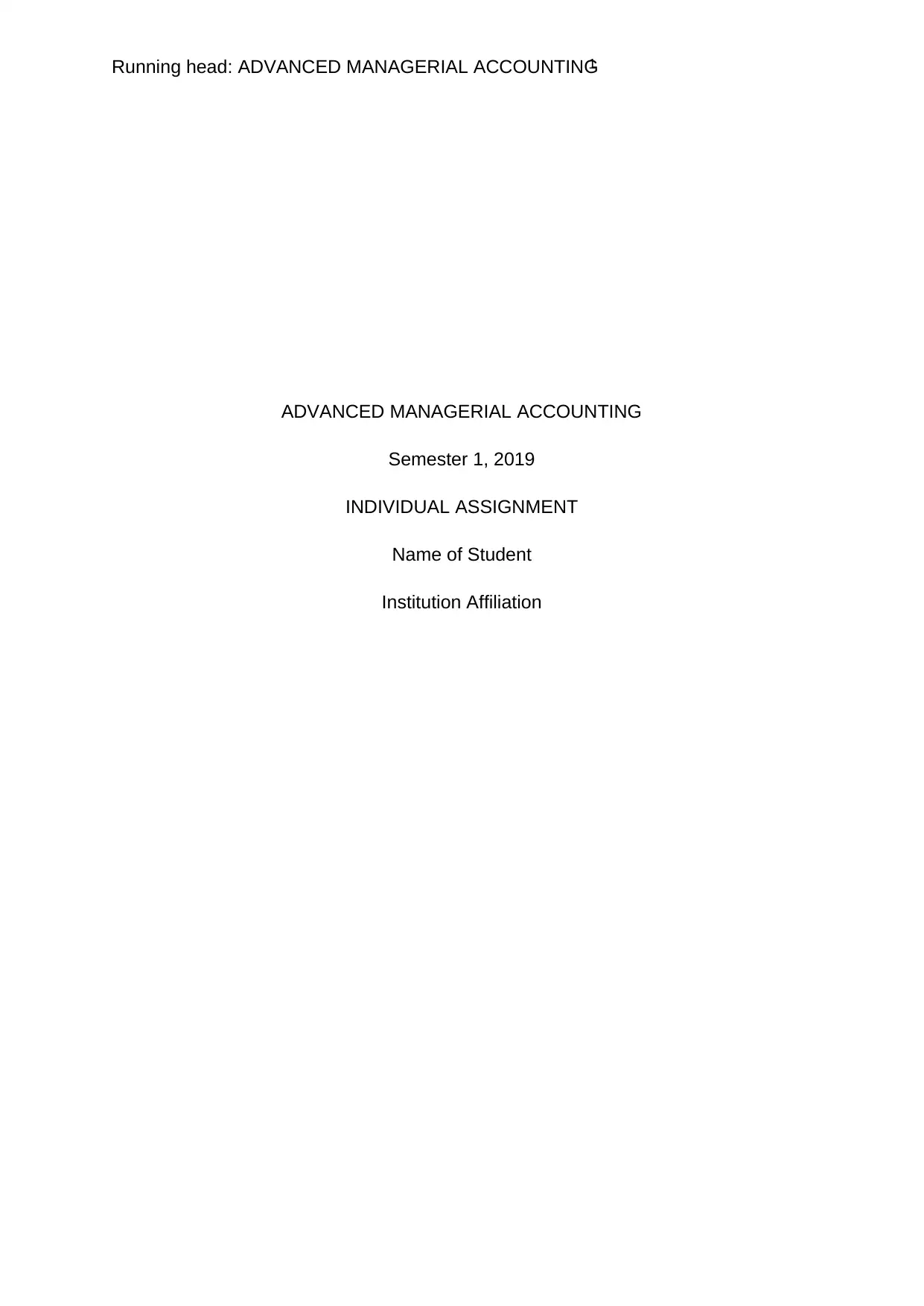
1Running head: ADVANCED MANAGERIAL ACCOUNTING
ADVANCED MANAGERIAL ACCOUNTING
Semester 1, 2019
INDIVIDUAL ASSIGNMENT
Name of Student
Institution Affiliation
ADVANCED MANAGERIAL ACCOUNTING
Semester 1, 2019
INDIVIDUAL ASSIGNMENT
Name of Student
Institution Affiliation
Paraphrase This Document
Need a fresh take? Get an instant paraphrase of this document with our AI Paraphraser
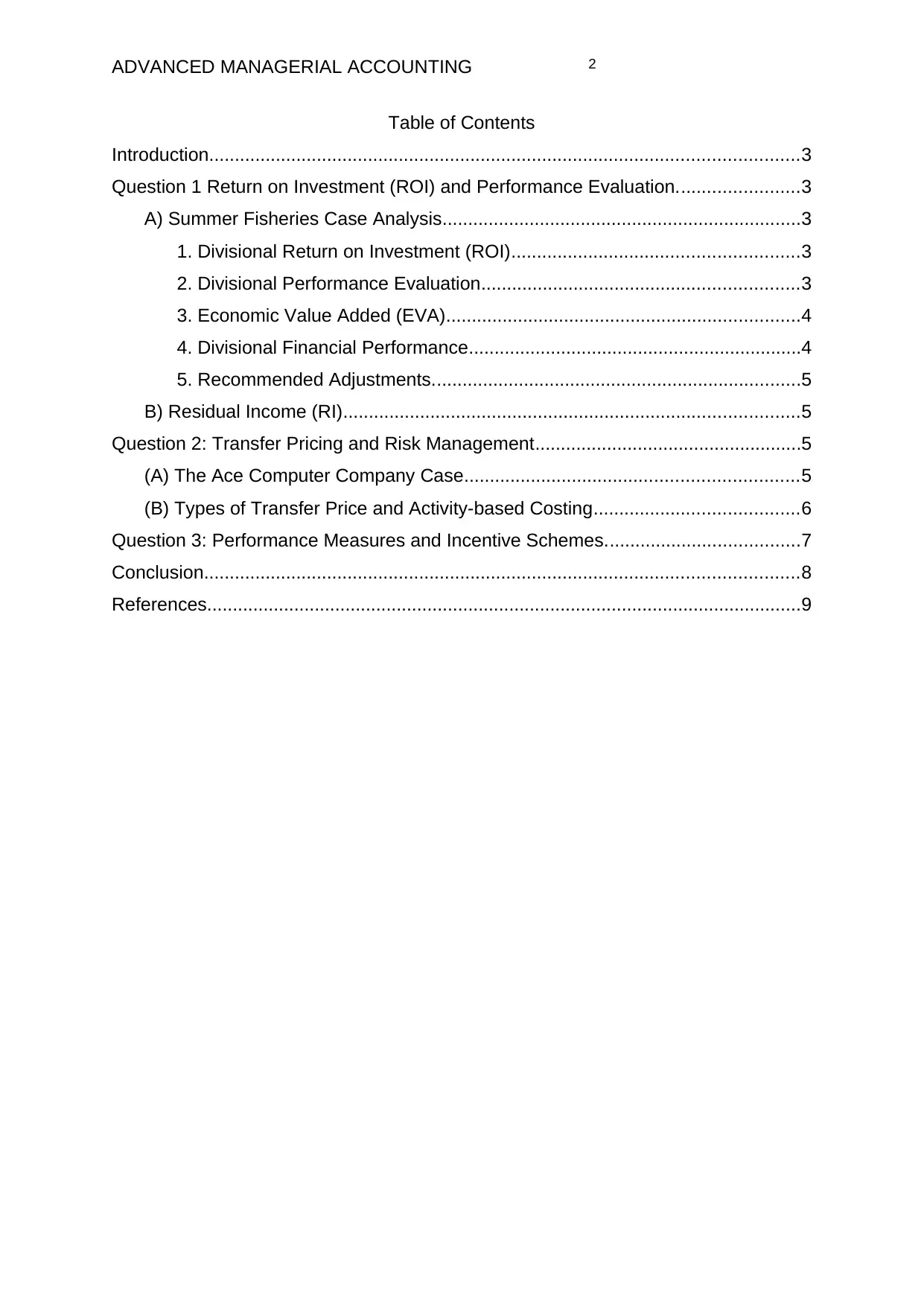
2ADVANCED MANAGERIAL ACCOUNTING
Table of Contents
Introduction...................................................................................................................3
Question 1 Return on Investment (ROI) and Performance Evaluation........................3
A) Summer Fisheries Case Analysis......................................................................3
1. Divisional Return on Investment (ROI)........................................................3
2. Divisional Performance Evaluation..............................................................3
3. Economic Value Added (EVA).....................................................................4
4. Divisional Financial Performance.................................................................4
5. Recommended Adjustments........................................................................5
B) Residual Income (RI).........................................................................................5
Question 2: Transfer Pricing and Risk Management....................................................5
(A) The Ace Computer Company Case.................................................................5
(B) Types of Transfer Price and Activity-based Costing........................................6
Question 3: Performance Measures and Incentive Schemes......................................7
Conclusion....................................................................................................................8
References....................................................................................................................9
Table of Contents
Introduction...................................................................................................................3
Question 1 Return on Investment (ROI) and Performance Evaluation........................3
A) Summer Fisheries Case Analysis......................................................................3
1. Divisional Return on Investment (ROI)........................................................3
2. Divisional Performance Evaluation..............................................................3
3. Economic Value Added (EVA).....................................................................4
4. Divisional Financial Performance.................................................................4
5. Recommended Adjustments........................................................................5
B) Residual Income (RI).........................................................................................5
Question 2: Transfer Pricing and Risk Management....................................................5
(A) The Ace Computer Company Case.................................................................5
(B) Types of Transfer Price and Activity-based Costing........................................6
Question 3: Performance Measures and Incentive Schemes......................................7
Conclusion....................................................................................................................8
References....................................................................................................................9
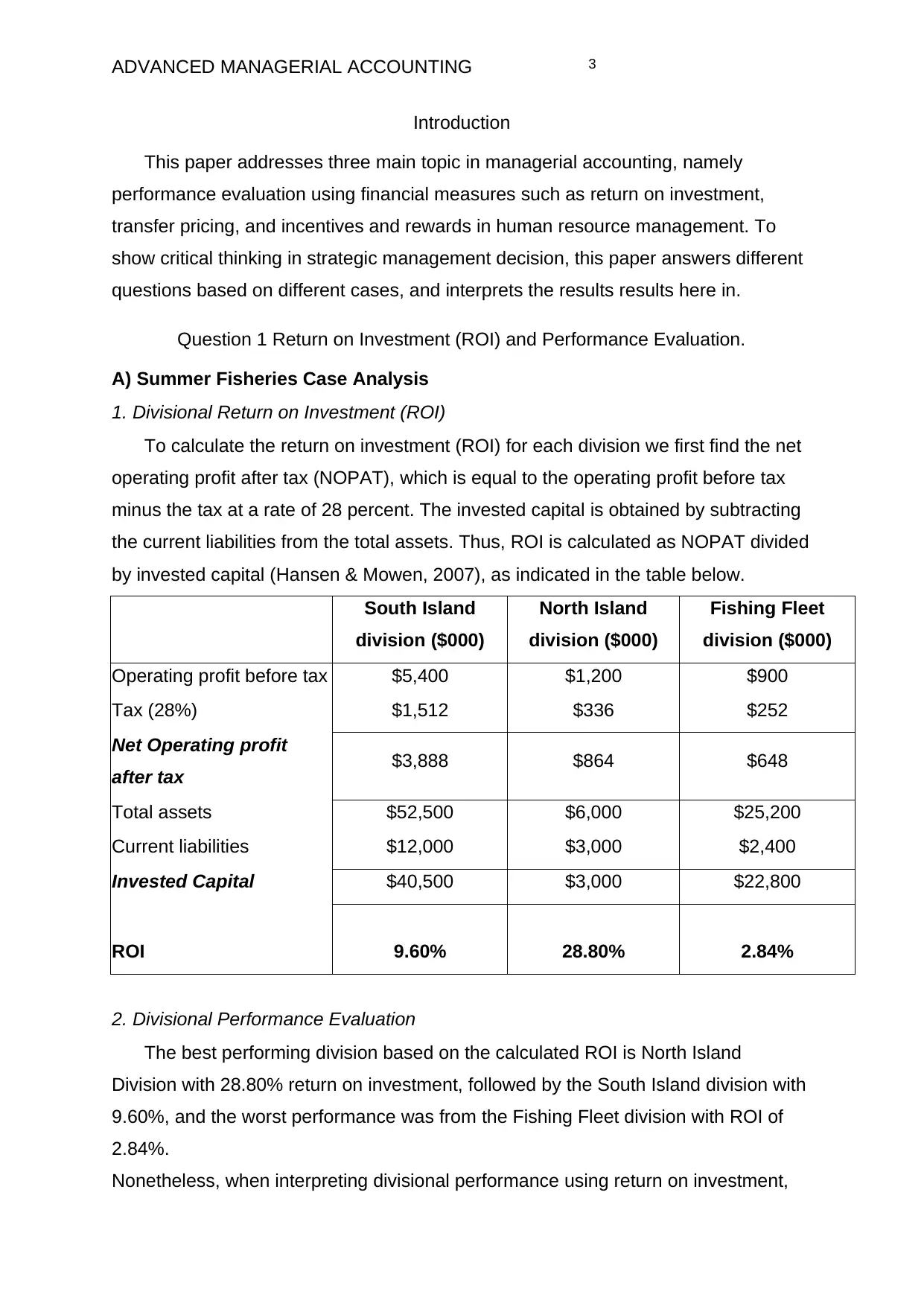
3ADVANCED MANAGERIAL ACCOUNTING
Introduction
This paper addresses three main topic in managerial accounting, namely
performance evaluation using financial measures such as return on investment,
transfer pricing, and incentives and rewards in human resource management. To
show critical thinking in strategic management decision, this paper answers different
questions based on different cases, and interprets the results results here in.
Question 1 Return on Investment (ROI) and Performance Evaluation.
A) Summer Fisheries Case Analysis
1. Divisional Return on Investment (ROI)
To calculate the return on investment (ROI) for each division we first find the net
operating profit after tax (NOPAT), which is equal to the operating profit before tax
minus the tax at a rate of 28 percent. The invested capital is obtained by subtracting
the current liabilities from the total assets. Thus, ROI is calculated as NOPAT divided
by invested capital (Hansen & Mowen, 2007), as indicated in the table below.
South Island
division ($000)
North Island
division ($000)
Fishing Fleet
division ($000)
Operating profit before tax $5,400 $1,200 $900
Tax (28%) $1,512 $336 $252
Net Operating profit
after tax $3,888 $864 $648
Total assets $52,500 $6,000 $25,200
Current liabilities $12,000 $3,000 $2,400
Invested Capital $40,500 $3,000 $22,800
ROI 9.60% 28.80% 2.84%
2. Divisional Performance Evaluation
The best performing division based on the calculated ROI is North Island
Division with 28.80% return on investment, followed by the South Island division with
9.60%, and the worst performance was from the Fishing Fleet division with ROI of
2.84%.
Nonetheless, when interpreting divisional performance using return on investment,
Introduction
This paper addresses three main topic in managerial accounting, namely
performance evaluation using financial measures such as return on investment,
transfer pricing, and incentives and rewards in human resource management. To
show critical thinking in strategic management decision, this paper answers different
questions based on different cases, and interprets the results results here in.
Question 1 Return on Investment (ROI) and Performance Evaluation.
A) Summer Fisheries Case Analysis
1. Divisional Return on Investment (ROI)
To calculate the return on investment (ROI) for each division we first find the net
operating profit after tax (NOPAT), which is equal to the operating profit before tax
minus the tax at a rate of 28 percent. The invested capital is obtained by subtracting
the current liabilities from the total assets. Thus, ROI is calculated as NOPAT divided
by invested capital (Hansen & Mowen, 2007), as indicated in the table below.
South Island
division ($000)
North Island
division ($000)
Fishing Fleet
division ($000)
Operating profit before tax $5,400 $1,200 $900
Tax (28%) $1,512 $336 $252
Net Operating profit
after tax $3,888 $864 $648
Total assets $52,500 $6,000 $25,200
Current liabilities $12,000 $3,000 $2,400
Invested Capital $40,500 $3,000 $22,800
ROI 9.60% 28.80% 2.84%
2. Divisional Performance Evaluation
The best performing division based on the calculated ROI is North Island
Division with 28.80% return on investment, followed by the South Island division with
9.60%, and the worst performance was from the Fishing Fleet division with ROI of
2.84%.
Nonetheless, when interpreting divisional performance using return on investment,
⊘ This is a preview!⊘
Do you want full access?
Subscribe today to unlock all pages.

Trusted by 1+ million students worldwide
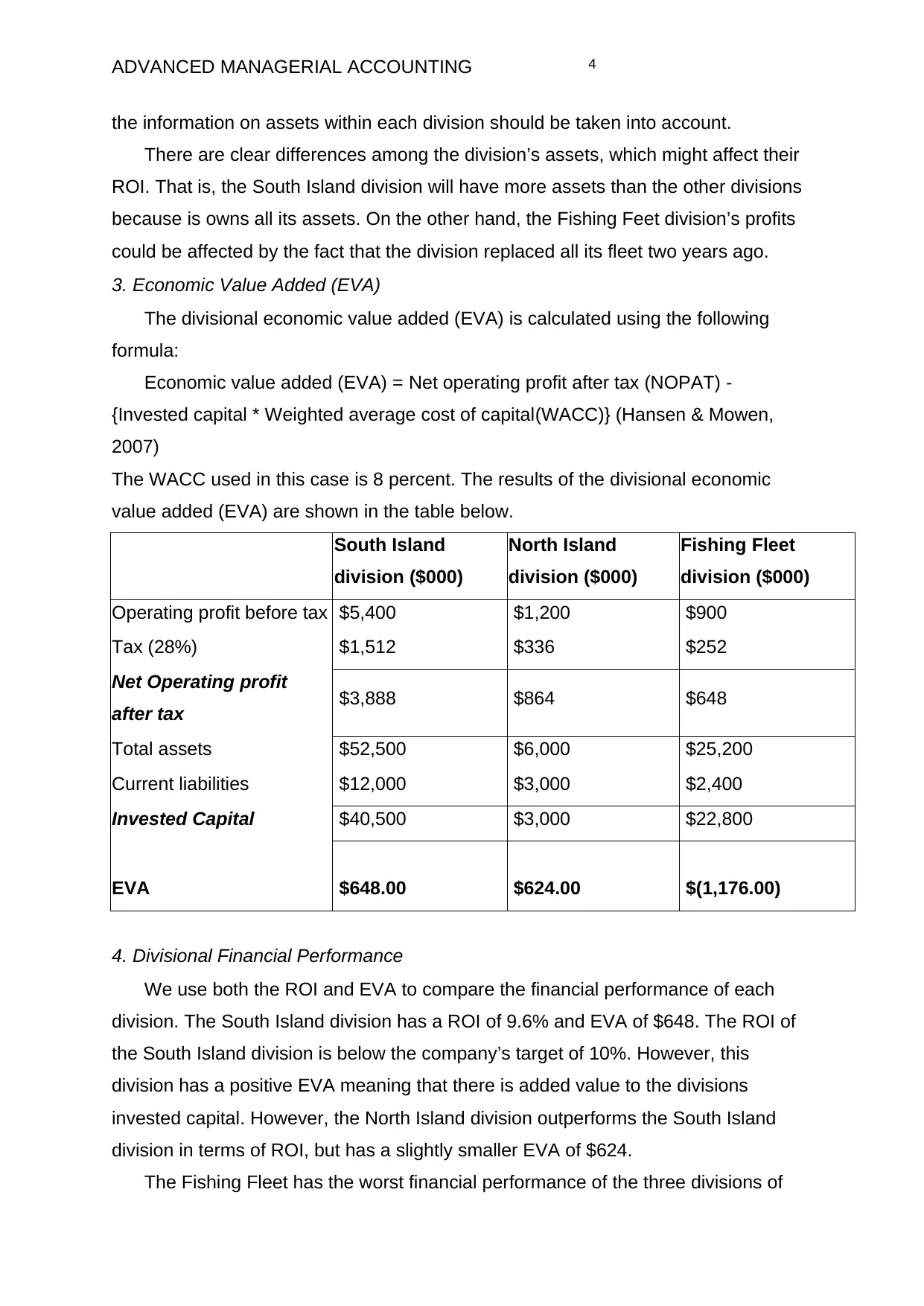
4ADVANCED MANAGERIAL ACCOUNTING
the information on assets within each division should be taken into account.
There are clear differences among the division’s assets, which might affect their
ROI. That is, the South Island division will have more assets than the other divisions
because is owns all its assets. On the other hand, the Fishing Feet division’s profits
could be affected by the fact that the division replaced all its fleet two years ago.
3. Economic Value Added (EVA)
The divisional economic value added (EVA) is calculated using the following
formula:
Economic value added (EVA) = Net operating profit after tax (NOPAT) -
{Invested capital * Weighted average cost of capital(WACC)} (Hansen & Mowen,
2007)
The WACC used in this case is 8 percent. The results of the divisional economic
value added (EVA) are shown in the table below.
South Island
division ($000)
North Island
division ($000)
Fishing Fleet
division ($000)
Operating profit before tax $5,400 $1,200 $900
Tax (28%) $1,512 $336 $252
Net Operating profit
after tax $3,888 $864 $648
Total assets $52,500 $6,000 $25,200
Current liabilities $12,000 $3,000 $2,400
Invested Capital $40,500 $3,000 $22,800
EVA $648.00 $624.00 $(1,176.00)
4. Divisional Financial Performance
We use both the ROI and EVA to compare the financial performance of each
division. The South Island division has a ROI of 9.6% and EVA of $648. The ROI of
the South Island division is below the company’s target of 10%. However, this
division has a positive EVA meaning that there is added value to the divisions
invested capital. However, the North Island division outperforms the South Island
division in terms of ROI, but has a slightly smaller EVA of $624.
The Fishing Fleet has the worst financial performance of the three divisions of
the information on assets within each division should be taken into account.
There are clear differences among the division’s assets, which might affect their
ROI. That is, the South Island division will have more assets than the other divisions
because is owns all its assets. On the other hand, the Fishing Feet division’s profits
could be affected by the fact that the division replaced all its fleet two years ago.
3. Economic Value Added (EVA)
The divisional economic value added (EVA) is calculated using the following
formula:
Economic value added (EVA) = Net operating profit after tax (NOPAT) -
{Invested capital * Weighted average cost of capital(WACC)} (Hansen & Mowen,
2007)
The WACC used in this case is 8 percent. The results of the divisional economic
value added (EVA) are shown in the table below.
South Island
division ($000)
North Island
division ($000)
Fishing Fleet
division ($000)
Operating profit before tax $5,400 $1,200 $900
Tax (28%) $1,512 $336 $252
Net Operating profit
after tax $3,888 $864 $648
Total assets $52,500 $6,000 $25,200
Current liabilities $12,000 $3,000 $2,400
Invested Capital $40,500 $3,000 $22,800
EVA $648.00 $624.00 $(1,176.00)
4. Divisional Financial Performance
We use both the ROI and EVA to compare the financial performance of each
division. The South Island division has a ROI of 9.6% and EVA of $648. The ROI of
the South Island division is below the company’s target of 10%. However, this
division has a positive EVA meaning that there is added value to the divisions
invested capital. However, the North Island division outperforms the South Island
division in terms of ROI, but has a slightly smaller EVA of $624.
The Fishing Fleet has the worst financial performance of the three divisions of
Paraphrase This Document
Need a fresh take? Get an instant paraphrase of this document with our AI Paraphraser
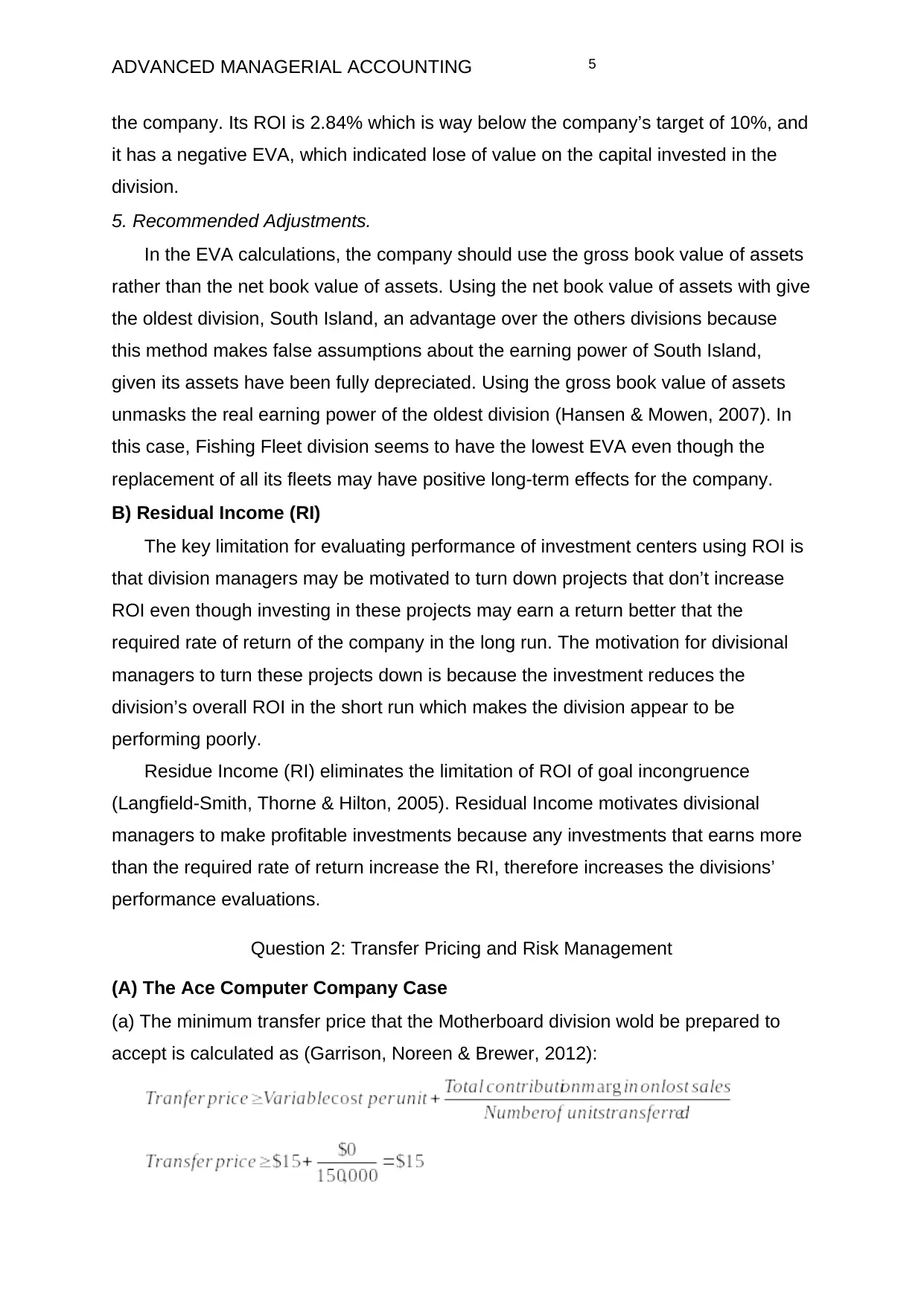
5ADVANCED MANAGERIAL ACCOUNTING
the company. Its ROI is 2.84% which is way below the company’s target of 10%, and
it has a negative EVA, which indicated lose of value on the capital invested in the
division.
5. Recommended Adjustments.
In the EVA calculations, the company should use the gross book value of assets
rather than the net book value of assets. Using the net book value of assets with give
the oldest division, South Island, an advantage over the others divisions because
this method makes false assumptions about the earning power of South Island,
given its assets have been fully depreciated. Using the gross book value of assets
unmasks the real earning power of the oldest division (Hansen & Mowen, 2007). In
this case, Fishing Fleet division seems to have the lowest EVA even though the
replacement of all its fleets may have positive long-term effects for the company.
B) Residual Income (RI)
The key limitation for evaluating performance of investment centers using ROI is
that division managers may be motivated to turn down projects that don’t increase
ROI even though investing in these projects may earn a return better that the
required rate of return of the company in the long run. The motivation for divisional
managers to turn these projects down is because the investment reduces the
division’s overall ROI in the short run which makes the division appear to be
performing poorly.
Residue Income (RI) eliminates the limitation of ROI of goal incongruence
(Langfield-Smith, Thorne & Hilton, 2005). Residual Income motivates divisional
managers to make profitable investments because any investments that earns more
than the required rate of return increase the RI, therefore increases the divisions’
performance evaluations.
Question 2: Transfer Pricing and Risk Management
(A) The Ace Computer Company Case
(a) The minimum transfer price that the Motherboard division wold be prepared to
accept is calculated as (Garrison, Noreen & Brewer, 2012):
the company. Its ROI is 2.84% which is way below the company’s target of 10%, and
it has a negative EVA, which indicated lose of value on the capital invested in the
division.
5. Recommended Adjustments.
In the EVA calculations, the company should use the gross book value of assets
rather than the net book value of assets. Using the net book value of assets with give
the oldest division, South Island, an advantage over the others divisions because
this method makes false assumptions about the earning power of South Island,
given its assets have been fully depreciated. Using the gross book value of assets
unmasks the real earning power of the oldest division (Hansen & Mowen, 2007). In
this case, Fishing Fleet division seems to have the lowest EVA even though the
replacement of all its fleets may have positive long-term effects for the company.
B) Residual Income (RI)
The key limitation for evaluating performance of investment centers using ROI is
that division managers may be motivated to turn down projects that don’t increase
ROI even though investing in these projects may earn a return better that the
required rate of return of the company in the long run. The motivation for divisional
managers to turn these projects down is because the investment reduces the
division’s overall ROI in the short run which makes the division appear to be
performing poorly.
Residue Income (RI) eliminates the limitation of ROI of goal incongruence
(Langfield-Smith, Thorne & Hilton, 2005). Residual Income motivates divisional
managers to make profitable investments because any investments that earns more
than the required rate of return increase the RI, therefore increases the divisions’
performance evaluations.
Question 2: Transfer Pricing and Risk Management
(A) The Ace Computer Company Case
(a) The minimum transfer price that the Motherboard division wold be prepared to
accept is calculated as (Garrison, Noreen & Brewer, 2012):
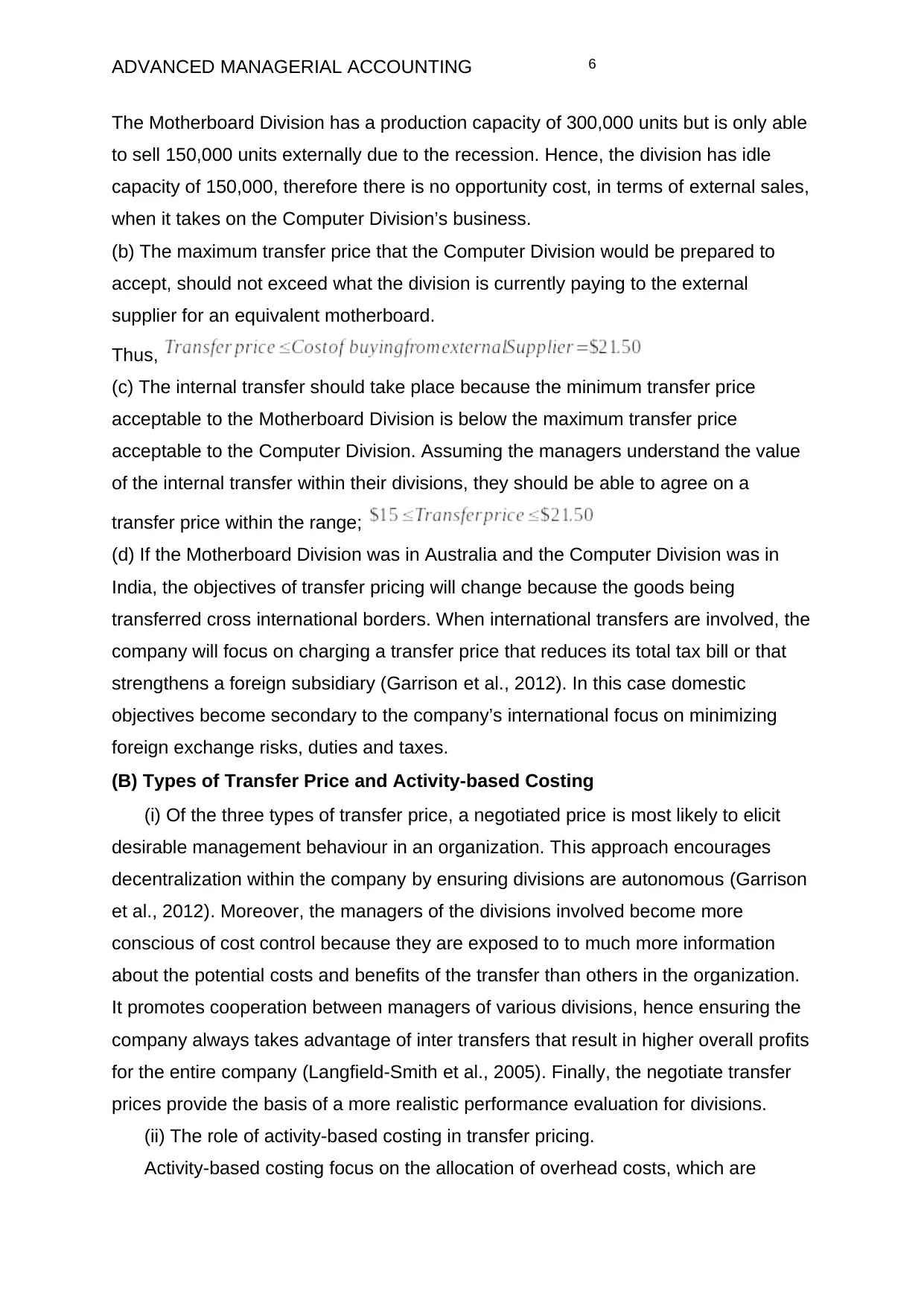
6ADVANCED MANAGERIAL ACCOUNTING
The Motherboard Division has a production capacity of 300,000 units but is only able
to sell 150,000 units externally due to the recession. Hence, the division has idle
capacity of 150,000, therefore there is no opportunity cost, in terms of external sales,
when it takes on the Computer Division’s business.
(b) The maximum transfer price that the Computer Division would be prepared to
accept, should not exceed what the division is currently paying to the external
supplier for an equivalent motherboard.
Thus,
(c) The internal transfer should take place because the minimum transfer price
acceptable to the Motherboard Division is below the maximum transfer price
acceptable to the Computer Division. Assuming the managers understand the value
of the internal transfer within their divisions, they should be able to agree on a
transfer price within the range;
(d) If the Motherboard Division was in Australia and the Computer Division was in
India, the objectives of transfer pricing will change because the goods being
transferred cross international borders. When international transfers are involved, the
company will focus on charging a transfer price that reduces its total tax bill or that
strengthens a foreign subsidiary (Garrison et al., 2012). In this case domestic
objectives become secondary to the company’s international focus on minimizing
foreign exchange risks, duties and taxes.
(B) Types of Transfer Price and Activity-based Costing
(i) Of the three types of transfer price, a negotiated price is most likely to elicit
desirable management behaviour in an organization. This approach encourages
decentralization within the company by ensuring divisions are autonomous (Garrison
et al., 2012). Moreover, the managers of the divisions involved become more
conscious of cost control because they are exposed to to much more information
about the potential costs and benefits of the transfer than others in the organization.
It promotes cooperation between managers of various divisions, hence ensuring the
company always takes advantage of inter transfers that result in higher overall profits
for the entire company (Langfield-Smith et al., 2005). Finally, the negotiate transfer
prices provide the basis of a more realistic performance evaluation for divisions.
(ii) The role of activity-based costing in transfer pricing.
Activity-based costing focus on the allocation of overhead costs, which are
The Motherboard Division has a production capacity of 300,000 units but is only able
to sell 150,000 units externally due to the recession. Hence, the division has idle
capacity of 150,000, therefore there is no opportunity cost, in terms of external sales,
when it takes on the Computer Division’s business.
(b) The maximum transfer price that the Computer Division would be prepared to
accept, should not exceed what the division is currently paying to the external
supplier for an equivalent motherboard.
Thus,
(c) The internal transfer should take place because the minimum transfer price
acceptable to the Motherboard Division is below the maximum transfer price
acceptable to the Computer Division. Assuming the managers understand the value
of the internal transfer within their divisions, they should be able to agree on a
transfer price within the range;
(d) If the Motherboard Division was in Australia and the Computer Division was in
India, the objectives of transfer pricing will change because the goods being
transferred cross international borders. When international transfers are involved, the
company will focus on charging a transfer price that reduces its total tax bill or that
strengthens a foreign subsidiary (Garrison et al., 2012). In this case domestic
objectives become secondary to the company’s international focus on minimizing
foreign exchange risks, duties and taxes.
(B) Types of Transfer Price and Activity-based Costing
(i) Of the three types of transfer price, a negotiated price is most likely to elicit
desirable management behaviour in an organization. This approach encourages
decentralization within the company by ensuring divisions are autonomous (Garrison
et al., 2012). Moreover, the managers of the divisions involved become more
conscious of cost control because they are exposed to to much more information
about the potential costs and benefits of the transfer than others in the organization.
It promotes cooperation between managers of various divisions, hence ensuring the
company always takes advantage of inter transfers that result in higher overall profits
for the entire company (Langfield-Smith et al., 2005). Finally, the negotiate transfer
prices provide the basis of a more realistic performance evaluation for divisions.
(ii) The role of activity-based costing in transfer pricing.
Activity-based costing focus on the allocation of overhead costs, which are
⊘ This is a preview!⊘
Do you want full access?
Subscribe today to unlock all pages.

Trusted by 1+ million students worldwide
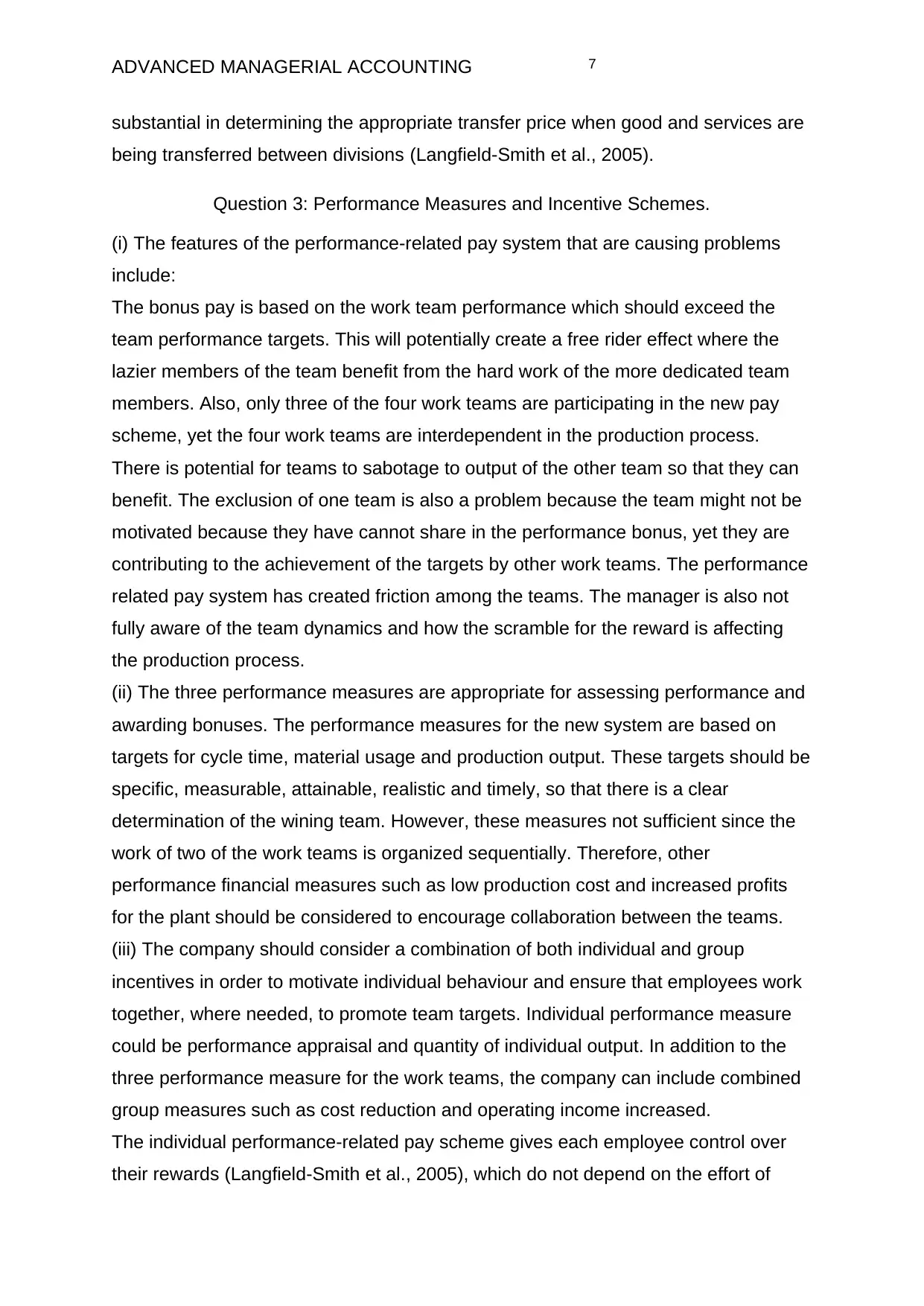
7ADVANCED MANAGERIAL ACCOUNTING
substantial in determining the appropriate transfer price when good and services are
being transferred between divisions (Langfield-Smith et al., 2005).
Question 3: Performance Measures and Incentive Schemes.
(i) The features of the performance-related pay system that are causing problems
include:
The bonus pay is based on the work team performance which should exceed the
team performance targets. This will potentially create a free rider effect where the
lazier members of the team benefit from the hard work of the more dedicated team
members. Also, only three of the four work teams are participating in the new pay
scheme, yet the four work teams are interdependent in the production process.
There is potential for teams to sabotage to output of the other team so that they can
benefit. The exclusion of one team is also a problem because the team might not be
motivated because they have cannot share in the performance bonus, yet they are
contributing to the achievement of the targets by other work teams. The performance
related pay system has created friction among the teams. The manager is also not
fully aware of the team dynamics and how the scramble for the reward is affecting
the production process.
(ii) The three performance measures are appropriate for assessing performance and
awarding bonuses. The performance measures for the new system are based on
targets for cycle time, material usage and production output. These targets should be
specific, measurable, attainable, realistic and timely, so that there is a clear
determination of the wining team. However, these measures not sufficient since the
work of two of the work teams is organized sequentially. Therefore, other
performance financial measures such as low production cost and increased profits
for the plant should be considered to encourage collaboration between the teams.
(iii) The company should consider a combination of both individual and group
incentives in order to motivate individual behaviour and ensure that employees work
together, where needed, to promote team targets. Individual performance measure
could be performance appraisal and quantity of individual output. In addition to the
three performance measure for the work teams, the company can include combined
group measures such as cost reduction and operating income increased.
The individual performance-related pay scheme gives each employee control over
their rewards (Langfield-Smith et al., 2005), which do not depend on the effort of
substantial in determining the appropriate transfer price when good and services are
being transferred between divisions (Langfield-Smith et al., 2005).
Question 3: Performance Measures and Incentive Schemes.
(i) The features of the performance-related pay system that are causing problems
include:
The bonus pay is based on the work team performance which should exceed the
team performance targets. This will potentially create a free rider effect where the
lazier members of the team benefit from the hard work of the more dedicated team
members. Also, only three of the four work teams are participating in the new pay
scheme, yet the four work teams are interdependent in the production process.
There is potential for teams to sabotage to output of the other team so that they can
benefit. The exclusion of one team is also a problem because the team might not be
motivated because they have cannot share in the performance bonus, yet they are
contributing to the achievement of the targets by other work teams. The performance
related pay system has created friction among the teams. The manager is also not
fully aware of the team dynamics and how the scramble for the reward is affecting
the production process.
(ii) The three performance measures are appropriate for assessing performance and
awarding bonuses. The performance measures for the new system are based on
targets for cycle time, material usage and production output. These targets should be
specific, measurable, attainable, realistic and timely, so that there is a clear
determination of the wining team. However, these measures not sufficient since the
work of two of the work teams is organized sequentially. Therefore, other
performance financial measures such as low production cost and increased profits
for the plant should be considered to encourage collaboration between the teams.
(iii) The company should consider a combination of both individual and group
incentives in order to motivate individual behaviour and ensure that employees work
together, where needed, to promote team targets. Individual performance measure
could be performance appraisal and quantity of individual output. In addition to the
three performance measure for the work teams, the company can include combined
group measures such as cost reduction and operating income increased.
The individual performance-related pay scheme gives each employee control over
their rewards (Langfield-Smith et al., 2005), which do not depend on the effort of
Paraphrase This Document
Need a fresh take? Get an instant paraphrase of this document with our AI Paraphraser
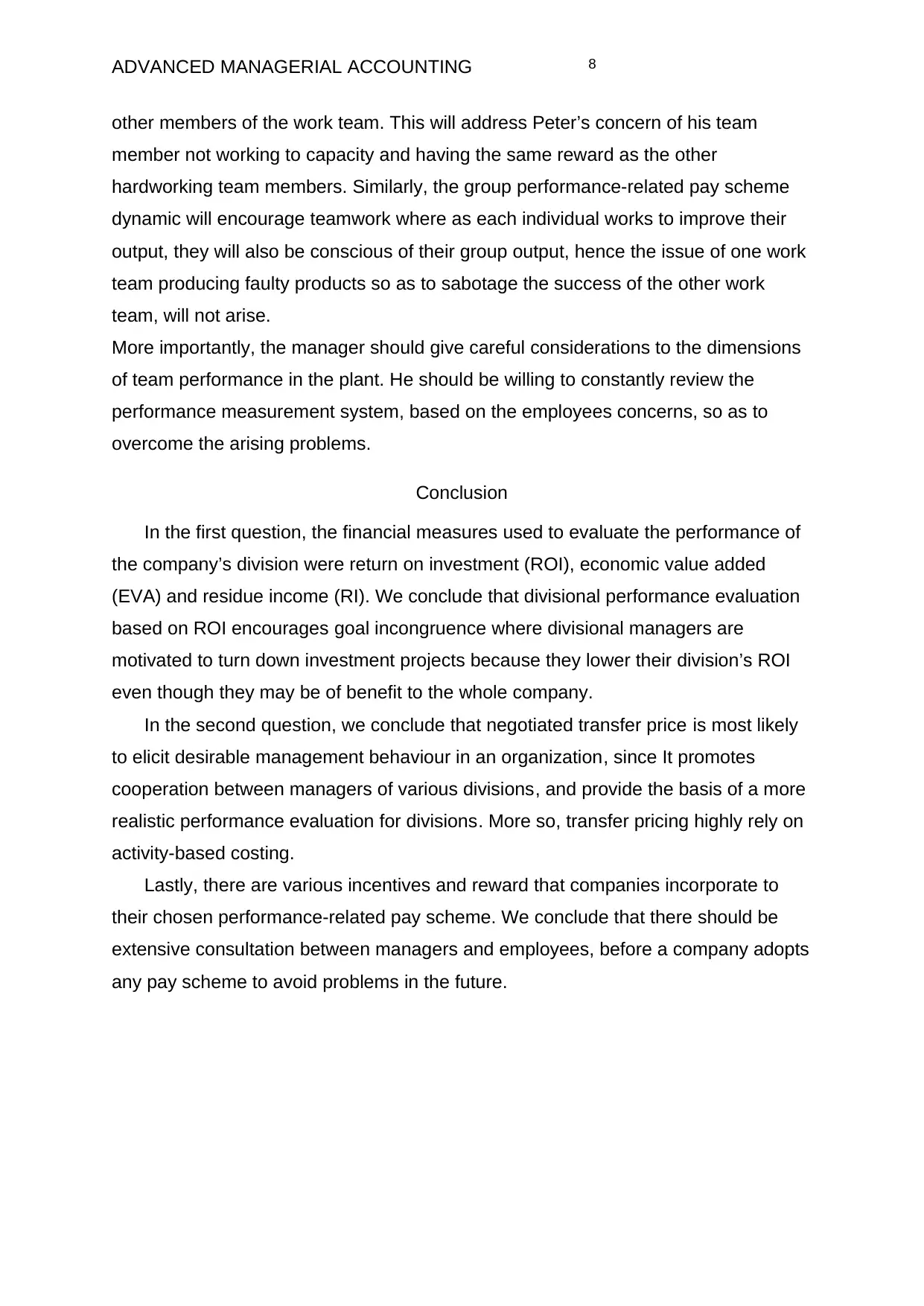
8ADVANCED MANAGERIAL ACCOUNTING
other members of the work team. This will address Peter’s concern of his team
member not working to capacity and having the same reward as the other
hardworking team members. Similarly, the group performance-related pay scheme
dynamic will encourage teamwork where as each individual works to improve their
output, they will also be conscious of their group output, hence the issue of one work
team producing faulty products so as to sabotage the success of the other work
team, will not arise.
More importantly, the manager should give careful considerations to the dimensions
of team performance in the plant. He should be willing to constantly review the
performance measurement system, based on the employees concerns, so as to
overcome the arising problems.
Conclusion
In the first question, the financial measures used to evaluate the performance of
the company’s division were return on investment (ROI), economic value added
(EVA) and residue income (RI). We conclude that divisional performance evaluation
based on ROI encourages goal incongruence where divisional managers are
motivated to turn down investment projects because they lower their division’s ROI
even though they may be of benefit to the whole company.
In the second question, we conclude that negotiated transfer price is most likely
to elicit desirable management behaviour in an organization, since It promotes
cooperation between managers of various divisions, and provide the basis of a more
realistic performance evaluation for divisions. More so, transfer pricing highly rely on
activity-based costing.
Lastly, there are various incentives and reward that companies incorporate to
their chosen performance-related pay scheme. We conclude that there should be
extensive consultation between managers and employees, before a company adopts
any pay scheme to avoid problems in the future.
other members of the work team. This will address Peter’s concern of his team
member not working to capacity and having the same reward as the other
hardworking team members. Similarly, the group performance-related pay scheme
dynamic will encourage teamwork where as each individual works to improve their
output, they will also be conscious of their group output, hence the issue of one work
team producing faulty products so as to sabotage the success of the other work
team, will not arise.
More importantly, the manager should give careful considerations to the dimensions
of team performance in the plant. He should be willing to constantly review the
performance measurement system, based on the employees concerns, so as to
overcome the arising problems.
Conclusion
In the first question, the financial measures used to evaluate the performance of
the company’s division were return on investment (ROI), economic value added
(EVA) and residue income (RI). We conclude that divisional performance evaluation
based on ROI encourages goal incongruence where divisional managers are
motivated to turn down investment projects because they lower their division’s ROI
even though they may be of benefit to the whole company.
In the second question, we conclude that negotiated transfer price is most likely
to elicit desirable management behaviour in an organization, since It promotes
cooperation between managers of various divisions, and provide the basis of a more
realistic performance evaluation for divisions. More so, transfer pricing highly rely on
activity-based costing.
Lastly, there are various incentives and reward that companies incorporate to
their chosen performance-related pay scheme. We conclude that there should be
extensive consultation between managers and employees, before a company adopts
any pay scheme to avoid problems in the future.

9ADVANCED MANAGERIAL ACCOUNTING
References
Garrison, R., Noreen, E., & Brewer, P. (2012). Managerial Accounting (14th ed.).
New York, NY: McGraw-Hill/Irwin.
Hansen, D., & Mowen, M. (2007). Managerial Accounting (8th ed.). Mason, OH:
Thomson/South-Western.
Langfield-Smith, K., Thorne, H., & Hilton, R. (2005). Management accounting.
Sydney: McGraw-Hill.
References
Garrison, R., Noreen, E., & Brewer, P. (2012). Managerial Accounting (14th ed.).
New York, NY: McGraw-Hill/Irwin.
Hansen, D., & Mowen, M. (2007). Managerial Accounting (8th ed.). Mason, OH:
Thomson/South-Western.
Langfield-Smith, K., Thorne, H., & Hilton, R. (2005). Management accounting.
Sydney: McGraw-Hill.
⊘ This is a preview!⊘
Do you want full access?
Subscribe today to unlock all pages.

Trusted by 1+ million students worldwide
1 out of 9
Your All-in-One AI-Powered Toolkit for Academic Success.
+13062052269
info@desklib.com
Available 24*7 on WhatsApp / Email
![[object Object]](/_next/static/media/star-bottom.7253800d.svg)
Unlock your academic potential
Copyright © 2020–2025 A2Z Services. All Rights Reserved. Developed and managed by ZUCOL.
